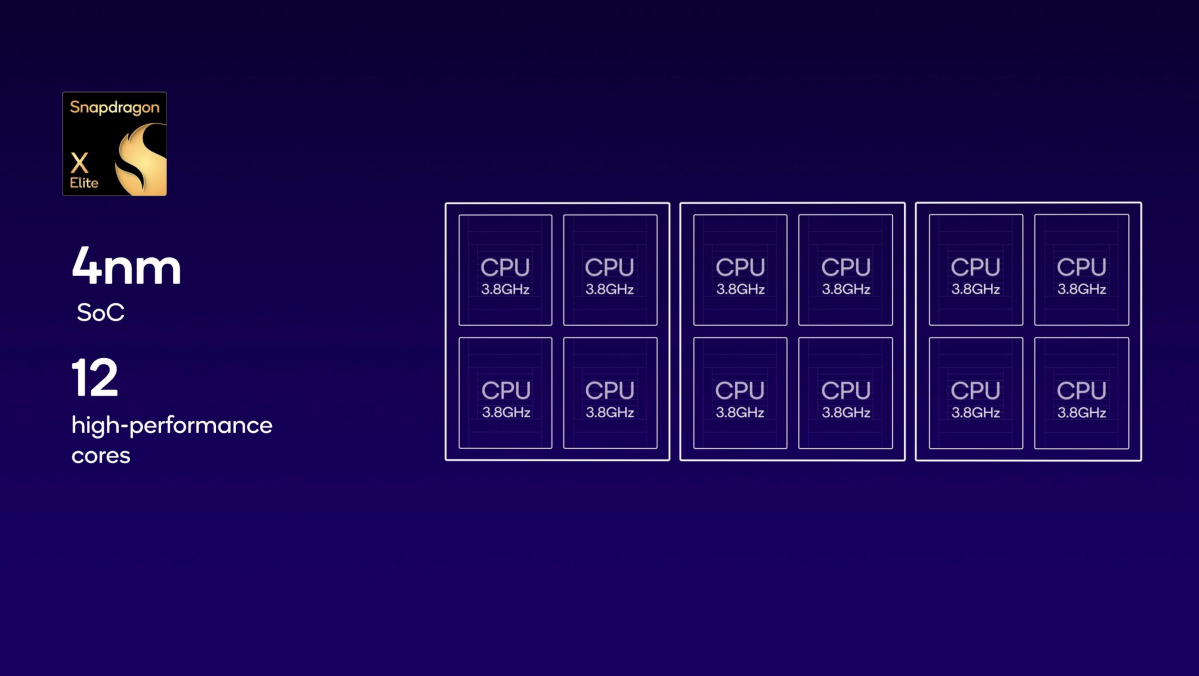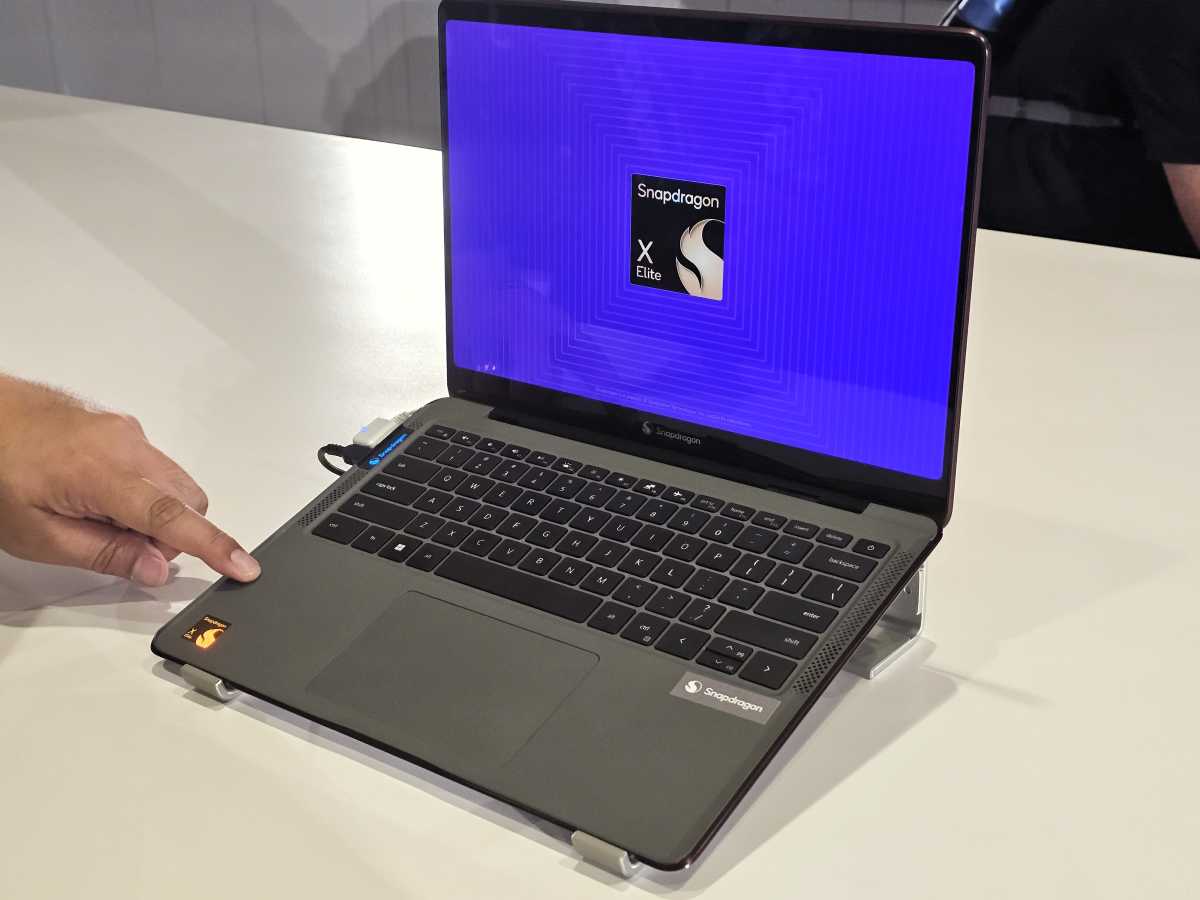Qualcomm's Snapdragon X Elite is the chip we begged Intel to make

 Image: Mark Hachman / IDG
Image: Mark Hachman / IDGQualcomm’s upcoming Snapdragon X Elite PC platform is weird.
Twelve cores, all running at 3.8GHz. Normal, right? Not for an Arm chip like Qualcomm manufactures. We’ve all become used to performance cores and efficiency cores, and trying to minimize battery life by turning off cores when not in use.
It’s become such an accepted part of chip design that Intel followed Arm’s lead and designed its 12th-gen “Alder Lake” notebook chips with a mix of performance and efficiency cores. Gamers fumed; why was Intel mixing in low-power, slower efficiency cores when all they wanted was raw speed instead?
Weirdly, that’s the approach Qualcomm has taken. It’s a potent combination: Snapdragon X Elite performance allegedly doubles Intel’s 13th-gen chips (a claim that has yet to be tested) while promising multiple days of battery life. Is that even remotely possible?

Mark Hachman / IDG
Mark Hachman / IDG
Mark Hachman / IDG
We don’t know. But what Kedar Kondap, Qualcomm’s senior vice president of compute and gaming, told attendees of the Snapdragon Technology Summit in Maui was that the Oryon CPU at the heart of the Snapdragon X Elite is made up of three clusters of four cores, all running at 3.8GHz. Two of those cores can boost up to 4.3GHz when needed, though how long they can stay there is unknown.
A performance chip…from Qualcomm?!
The bottom line is every Oryon core in the Snapdragon X Elite is a performance core, something that Intel simply refuses to do. And the total performance (apparently) outpaces Intel’s own. Furthermore, a Snapdragon X Elite can keep your laptop running for multiple days, Qualcomm says.
“At the end of the day, it all comes down to battery life,” Kondap said.
“Even with all the twelve being performance cores, [they] were significantly better in efficiency than a lot of what you can get in the market today,” Kondap added.
Don’t get me wrong: Intel could. At every launch, including the recent debut of its 14th-gen “Meteor Lake” chip in Malaysia, reporters asked about whether Intel would sell an all-performance-core design. But Intel has moved in the opposite direction. Intel’s Thread Director, which routes tasks to the appropriate cores, now pushes some threads to a new low-power efficiency core instead.

Qualcomm
Qualcomm
Qualcomm
To be fair, rival AMD has yet to adopt the approach of mixing powerful performance cores with efficiency cores for background tasks. But Intel has simply decided not to market mobile processors where the sky’s the limit.
Unfortunately, we don’t know much more about Qualcomm’s Snapdragon X Elite chips. They run the Arm v8 instruction set, specifically, Arm v8.7, Nitin Kumar, senior director of product management said. Each cluster of four CPU cores has 12MB of level-2 cache attached, a detail that matters to chip nerds.
The more interesting question is how Qualcomm markets its Snapdragon X Elite platform. Kondap said that the three reference platforms being shown off are 12W, 23W, and 45W, with the latter able to scale to 80W if necessary. Kondap also said that it was “interesting” that an analyst noted that one group of cores could be sliced off to enable a cheaper, slower, 8-core design.

Qualcomm
Qualcomm
Qualcomm
Executives also tamped down expectations regarding the gaming capabilities Qualcomm showed off earlier on Wednesday. “We’re focused on consumer,” Kondap said. “We’re focused on enterprise. We’re focused on prosumer based laptops.”
“Everybody wants to play games casually. Everybody wants to play, be a creator and be able to create content… We’re not in the high-end gaming market.”

Mark Hachman / IDG
Mark Hachman / IDG
Mark Hachman / IDG
Nothing in the chip prohibits connecting to an external GPU, and Qualcomm is simply working to establish the relationships with game and API developers for the future, executives said.
“We have aspirations,” Kondap said.
Editor’s Note: To gain access to Qualcomm’s new Oryon and Snapdragon X Elite platform, Qualcomm offered to pay for PCWorld for room, board and airfare at its Snapdragon Technology Summit. PCWorld accepted, but maintained editorial control of its content.
Author: Mark Hachman, Senior Editor

As PCWorld’s senior editor, Mark focuses on Microsoft news and chip technology, among other beats. He has formerly written for PCMag, BYTE, Slashdot, eWEEK, and ReadWrite.
Recent stories by Mark Hachman:
Dell hack: Personal info of 49 million customers allegedly breachedAMD gains big in desktop CPUs versus Intel in first quarter 2024No, Intel isn’t recommending baseline power profiles to fix crashing CPUs






